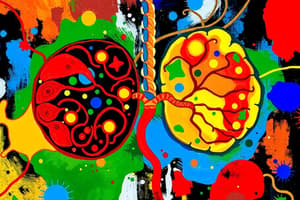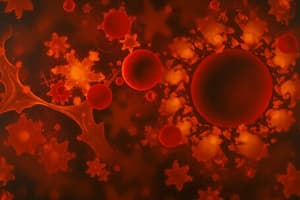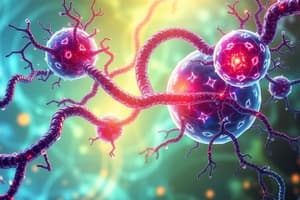Podcast
Questions and Answers
What is the primary function of the electron transport chain in oxidative phosphorylation?
What is the primary function of the electron transport chain in oxidative phosphorylation?
- To remove oxygen from the mitochondria
- To create a proton gradient across the mitochondrial membrane (correct)
- To produce glucose from carbon dioxide
- To synthesize ATP directly from glucose
Which phase of oxidative phosphorylation is responsible for ATP synthesis through chemiosmosis?
Which phase of oxidative phosphorylation is responsible for ATP synthesis through chemiosmosis?
- Electron transport chain
- Chemiosmosis (correct)
- Photolysis
- Substrate-level phosphorylation
What is the net ATP yield from glycolysis?
What is the net ATP yield from glycolysis?
- 2 ATP (correct)
- 0 ATP
- 4 ATP
- 6 ATP
How much ATP is generated from 1 molecule of NADH during oxidative phosphorylation?
How much ATP is generated from 1 molecule of NADH during oxidative phosphorylation?
What is the average total yield of ATP per molecule of glucose during cellular respiration?
What is the average total yield of ATP per molecule of glucose during cellular respiration?
What purpose does the proton gradient serve in the mitochondrial membrane during cellular respiration?
What purpose does the proton gradient serve in the mitochondrial membrane during cellular respiration?
What is the total amount of ATP generated through substrate-level phosphorylation in the citric acid cycle?
What is the total amount of ATP generated through substrate-level phosphorylation in the citric acid cycle?
Which of the following correctly describes FADH2's contribution to ATP yield?
Which of the following correctly describes FADH2's contribution to ATP yield?
What is the primary method of water intake in the body?
What is the primary method of water intake in the body?
What structure in the kidney is primarily responsible for filtering blood?
What structure in the kidney is primarily responsible for filtering blood?
What percentage of water output is accounted for by urine?
What percentage of water output is accounted for by urine?
Which type of cells are responsible for forming the visceral layer of the glomerular capsule?
Which type of cells are responsible for forming the visceral layer of the glomerular capsule?
What triggers the release of ADH in the body?
What triggers the release of ADH in the body?
Which of the following describes a consequence of decreased osmolality?
Which of the following describes a consequence of decreased osmolality?
What happens to larger substances in the filtration process of the glomerulus?
What happens to larger substances in the filtration process of the glomerulus?
Which part of the nephron receives the filtrate from the glomerular capsule?
Which part of the nephron receives the filtrate from the glomerular capsule?
What is the typical range of osmolality maintained in the body fluids?
What is the typical range of osmolality maintained in the body fluids?
What is the function of the efferent arteriole in the kidney's filtration system?
What is the function of the efferent arteriole in the kidney's filtration system?
What happens to cells when excessive water is gained compared to solutes?
What happens to cells when excessive water is gained compared to solutes?
What characterizes edema in tissue?
What characterizes edema in tissue?
Which ion is the predominant cation in extracellular fluid (ECF)?
Which ion is the predominant cation in extracellular fluid (ECF)?
What triggers aldosterone release from the adrenal cortex?
What triggers aldosterone release from the adrenal cortex?
How does sodium affect water distribution in the body?
How does sodium affect water distribution in the body?
What is the impact of changes in sodium levels on blood pressure?
What is the impact of changes in sodium levels on blood pressure?
What is the role of renin in sodium and fluid regulation?
What is the role of renin in sodium and fluid regulation?
How does edema affect tissue function?
How does edema affect tissue function?
What is the normal pH of arterial blood?
What is the normal pH of arterial blood?
Which condition is indicated by arterial pH greater than 7.45?
Which condition is indicated by arterial pH greater than 7.45?
What are the main processes occurring in the renal tubule?
What are the main processes occurring in the renal tubule?
What part of the nephron is responsible for filtration?
What part of the nephron is responsible for filtration?
What is the pH of intracellular fluid (ICF)?
What is the pH of intracellular fluid (ICF)?
Which of the following statements about acid-base balance is correct?
Which of the following statements about acid-base balance is correct?
What is the pH range for venous blood and interstitial fluid?
What is the pH range for venous blood and interstitial fluid?
Which structure in the nephron is responsible for reabsorption?
Which structure in the nephron is responsible for reabsorption?
Which cell types are found in the collecting duct?
Which cell types are found in the collecting duct?
What occurs when the arterial pH drops below 7.35?
What occurs when the arterial pH drops below 7.35?
What type of epithelium lines the parietal layer of the glomerular capsule?
What type of epithelium lines the parietal layer of the glomerular capsule?
Which nephron type features a glomerulus located further from the cortex-medulla junction?
Which nephron type features a glomerulus located further from the cortex-medulla junction?
What is the main function of the proximal convoluted tubule?
What is the main function of the proximal convoluted tubule?
What characterizes the distal convoluted tubule compared to the proximal convoluted tubule?
What characterizes the distal convoluted tubule compared to the proximal convoluted tubule?
Which structure directly supplies blood to the peritubular capillaries?
Which structure directly supplies blood to the peritubular capillaries?
Which nephron is associated with a longer nephron loop and increased water reabsorption?
Which nephron is associated with a longer nephron loop and increased water reabsorption?
What connects the glomerulus to the collecting duct?
What connects the glomerulus to the collecting duct?
Which vessel is involved in draining blood from the nephrons?
Which vessel is involved in draining blood from the nephrons?
What is the functional significance of the glomerular capsular space?
What is the functional significance of the glomerular capsular space?
Which of the following structures is primarily responsible for the reabsorption of water in the nephron?
Which of the following structures is primarily responsible for the reabsorption of water in the nephron?
Flashcards
Oxidative phosphorylation
Oxidative phosphorylation
Two-phase process that uses high-energy electrons to create an H+ gradient, driving ATP synthesis.
Electron transport chain
Electron transport chain
Phase 1 of oxidative phosphorylation. Creates a proton gradient with high-energy electron transfer.
Chemiosmosis
Chemiosmosis
Phase 2 of oxidative phosphorylation. Uses the energy of the proton gradient to create ATP.
ATP synthase
ATP synthase
Signup and view all the flashcards
Glycolysis
Glycolysis
Signup and view all the flashcards
Pyruvic acid
Pyruvic acid
Signup and view all the flashcards
Citric acid cycle
Citric acid cycle
Signup and view all the flashcards
ATP yield of cellular respiration
ATP yield of cellular respiration
Signup and view all the flashcards
Water intake
Water intake
Signup and view all the flashcards
Water output
Water output
Signup and view all the flashcards
ECF Osmolality
ECF Osmolality
Signup and view all the flashcards
Osmolality range
Osmolality range
Signup and view all the flashcards
Osmolality imbalance triggers
Osmolality imbalance triggers
Signup and view all the flashcards
Hypotonic Hydration
Hypotonic Hydration
Signup and view all the flashcards
ECF Osmotic Pressure
ECF Osmotic Pressure
Signup and view all the flashcards
Sodium's Role in Fluid Balance
Sodium's Role in Fluid Balance
Signup and view all the flashcards
Edema
Edema
Signup and view all the flashcards
Renin-Angiotensin Mechanism
Renin-Angiotensin Mechanism
Signup and view all the flashcards
Aldosterone's Effect
Aldosterone's Effect
Signup and view all the flashcards
Angiotensin II
Angiotensin II
Signup and view all the flashcards
Interstitial Fluid (IF)
Interstitial Fluid (IF)
Signup and view all the flashcards
Glomerular Filtration
Glomerular Filtration
Signup and view all the flashcards
Filtration Membrane
Filtration Membrane
Signup and view all the flashcards
Glomerular Capillary
Glomerular Capillary
Signup and view all the flashcards
Podocytes
Podocytes
Signup and view all the flashcards
Renal Corpuscle
Renal Corpuscle
Signup and view all the flashcards
pH
pH
Signup and view all the flashcards
Acid-Base Balance
Acid-Base Balance
Signup and view all the flashcards
Normal pH of Arterial Blood
Normal pH of Arterial Blood
Signup and view all the flashcards
Alkalosis
Alkalosis
Signup and view all the flashcards
Acidosis
Acidosis
Signup and view all the flashcards
Kidney's Role in Acid-Base Balance
Kidney's Role in Acid-Base Balance
Signup and view all the flashcards
Nephron
Nephron
Signup and view all the flashcards
Renal Tubule
Renal Tubule
Signup and view all the flashcards
Glomerulus
Glomerulus
Signup and view all the flashcards
Bowman's Capsule
Bowman's Capsule
Signup and view all the flashcards
Proximal Convoluted Tubule (PCT)
Proximal Convoluted Tubule (PCT)
Signup and view all the flashcards
Distal Convoluted Tubule (DCT)
Distal Convoluted Tubule (DCT)
Signup and view all the flashcards
Nephron Loop (Loop of Henle)
Nephron Loop (Loop of Henle)
Signup and view all the flashcards
Collecting Duct
Collecting Duct
Signup and view all the flashcards
Cortical Nephron
Cortical Nephron
Signup and view all the flashcards
Juxtamedullary Nephron
Juxtamedullary Nephron
Signup and view all the flashcards
Vasa Recta
Vasa Recta
Signup and view all the flashcards
Study Notes
Anabolism and Catabolism
- Anabolism is the synthesis of large molecules from smaller ones. An example is the synthesis of proteins from amino acids.
- Catabolism is the hydrolysis of complex structures into simpler ones. An example is the breakdown of proteins into amino acids. Hydrolysis breaks down polymers. This process shares the same root as the word "catastrophic".
Cellular Respiration
- Cellular respiration is the catabolic breakdown of food that captures energy from food to form ATP.
- The goal of cellular respiration is to trap chemical energy in ATP.
- Energy can be stored in glycogen and fats for later use.
- Phosphorylation is when enzymes shift high-energy phosphate groups from ATP to other molecules.
- Phosphorylated molecules become activated to perform cellular functions. This is a quick way to create ATP.
Three Stages in Processing Nutrients
- Stage 1: Digestion, absorption and transport to tissues.
- Stage 2: Cellular processing (in cytoplasm)
- Synthesis of lipids, proteins, and glycogen
- Catabolism (glycolysis) into pyruvic acid and acetyl CoA
- Stage 3: Oxidative breakdown of intermediates into CO2, water and ATP.
- This process occurs in mitochondria.
- Cellular respiration consists of glycolysis of stage 2 and all of stage 3.
Oxidation-Reduction (Redox) Reactions
- Oxidation reactions involve the gain of oxygen or loss of hydrogen atoms (and their electrons).
- In a redox reaction, oxidized substances lose electrons and energy.
- Reduced substances gain electrons and energy.
- Redox reactions are catalyzed by enzymes that usually require a B vitamin coenzyme.
ATP Synthesis
- Two mechanisms are used to make ATP from captured energy during cellular respiration:
-
- Substrate-level phosphorylation involves high-energy phosphate groups being directly transferred from phosphorylated substrates to ADP. An example is the phosphagen system in skeletal muscle.
-
- Oxidative phosphorylation is a more complex process that produces most ATP. Chemiosmosis couples the movement of substances across membranes to chemical reactions. Energy released from oxidizing food is used to pump H+ across the inner mitochondrial membrane, creating a steep H+ concentration gradient. Electrons transfer through transport proteins to create a proton gradient. ATP synthase uses the energy of the protons to bind phosphate groups to ADP.
-
Oxidation of Glucose
- Glucose is oxidized via the following reaction: C6H12O6 + 6O2 → 6H2O + CO2 + 32ATP + heat
- Complete glucose catabolism requires three pathways:
-
- Glycolysis: glucose splitting in half
-
- Krebs cycle (Citric acid cycle): making several intermediates.
-
- Electron transport chain and oxidative phosphorylation.
-
Glycogenesis, Glycogenolysis, and Gluconeogenesis
- Glycogenesis: stores glucose by making glycogen to store glucose when levels are high
- Glycogenolysis: breakdown of glycogen to glucose monomers when blood glucose levels are low
- Gluconeogenesis: forming new glucose from noncarbohydrate sources such as fats and proteins when blood glucose levels drop.
Lipid Metabolism
- Lipids provide a greater energy yield than either glucose or protein.
- Fat catabolism yields 9 kcal per gram of carbohydrate or protein.
- Only triglycerides are routinely oxidized for energy. -Glycerol breakdown: treat as glucose -Fatty acid breakdown: fatty acids undergo Beta oxidation in mitochondria
- Ketogenesis in liver converts accumulated acetyl CoA to ketone bodies (ketones) if carbohydrate intake is inadequate. The buildup of ketones can cause metabolic acidosis.
Water, Electrolyte, and Acid-Base Balance
- Body Water Content:
- Infants have more water than adult males and females (who tend to have higher fat content and less skeletal muscle mass.)
- Water is less prevalent in adipose tissue.
- The average water content declines to ~45% in old age.
- Body Fluid Compartments:
- Intracellular fluid (ICF): ~25L, 40% of body weight
- Interstitial fluid (IF): ~12L, 80% of ECF
- Plasma: ~3L, 20% of ECF,
- Electrolytes: dissociate into ions in water, examples include inorganic salts, acids, bases, and some proteins. They conduct current and have greater osmotic power, and ability to cause fluid shifts.
- Water intake and output must equal each other.
- ECF osmolality is maintained near 280-300 mOsm.
Disorders of Water Balance
- Dehydration: ECF water loss due to hemorrhage, burns, vomiting, diarrhea, etc. -Signs and symptoms of dehydration include "cottony" oral mucosa, thirst, dry flushed skin, and oliguria. -Results can include weight loss, fever, mental confusion, hypovolemic shock, and electrolyte loss.
- Hypotonic hydration: ECF osmolality decreases,causing osmosis of water into the tissues' cells. -Signs can include severe metabolic disturbances, nausea, vomiting, muscular cramping, and cerebral edema.
- Edema: Atypical accumulation of interstitial fluid causing tissue swelling. This can impair tissue function by increasing the distance for oxygen and nutrient diffusion into cells.
Renal Clearance
- Volume of plasma that the kidneys can clear of a given substance in a given time, used to determine GFR
- Inulin can be used to measure GFR, as it is freely filtered and not reabsorbed or secreted. GFR is approximately 125 ml/min.
Urine
- Urine is the filtrate of blood minus useful substances, representing about 1 percent of the original filtrate. It contains metabolic wastes and unneeded substances.
- Other normal solutes found in urine include Na+, K+, PO43−, and SO42− Ca2+, Mg2+ and HCO3−
- Abnormally high concentrations of any constituent, or abnormal components such as blood proteins, WBCs, and bile pigments, could indicate a pathology problem.
- Normal urine has a slightly acidic pH (range 4.5-8.0) and a slightly aromatic odor .
- Cloudiness or abnormal color may indicate an infection or other relevant problem.
- Specific gravity is between 1.001 to 1.035.
Regulation of Water Intake
- Thirst mechanism is driven by the hypothalamic thirst center..
- Osmoreceptors in the hypothalamus detect changes in ECF osmolality, and are triggered when plasma osmolality rises 1-2%, or in cases of decrease in blood volume or pressure , triggered by Angiotensin II or a decrease in blood volume or pressure.
Studying That Suits You
Use AI to generate personalized quizzes and flashcards to suit your learning preferences.




